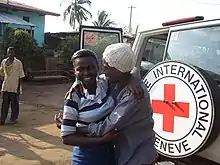Family Tracing and Reunification
Family Tracing and Reunification (known as FTR) is a process whereby disaster response teams locate separated family members and reunite them following natural and human catastrophes.[1] During major crises, children can become separated from their families for a wide range of reasons, and government disaster relief agencies as well as NGOs have developed inter-agency procedures to return children, and other vulnerable people, to their families.[2][3][4]

Mobile technology
UNICEF has developed a tool called RapidFTR that uses smartphones to register and monitor children who have become separated during a natural disaster or conflict, with a view to reunifying children with their parents.[5][6][7][8] While the tool has been assessed as having some benefits, it has reportedly encountered significant challenges relating to relevance of the design and heavy dependence on internet in contexts with limited access. The RapidFTR platform showed some promise and was used to track displaced children after Typhoon Haiyan[9] in the Philippines, but has been phased out in the more sizable South Sudan response in favour of more contextually suitable methods of registering separated families and managing related data.[10]
See also
References
- "Inter-agency Guiding Principles on UNACCOMPANIED and SEPARATED CHILDREN" (PDF). International Committee of the Red Cross. Jan 2004.
- "THE LOST ONES: EMERGENCY CARE AND FAMILY TRACING FOR CHILDREN FROM BIRTH TO FIVE YEARS". Child Rights International Network. 6 Jan 2007.
- Catherine Panter-Brick (3 Aug 2000). Abandoned Children. Cambridge University Press. ISBN 9780521775557.
- Jastram, Kate and Newland, Kathleen, Family Unity and Refugee Protection (2003). REFUGEE PROTECTION IN INTERNATIONAL LAW: UNHCR'S GLOBAL CONSULTATIONS ON INTERNATIONAL PROTECTION, E. Feller, V. Türk, and F. Nicholson, eds., pp. 555-603, Cambridge University Press, 2003 . Available at SSRN: http://ssrn.com/abstract=1559469 or doi:10.2139/ssrn.1559469
- "RAPIDFTR, AN APP FOR REUNITING FAMILIES IN DISASTER SITUATIONS". UNICEF. 31 Dec 2013.
- "THE VOLUNTEER COMMUNITY BEHIND THE APP: RAPIDFTR AND AN OPEN-SOURCE FORCE FOR CHANGE". UNICEF. 5 Jan 2014.
- "Separated from your family in a natural disaster? There's an app for that". The Guardian. 27 Dec 2013.
- "Mobile App Speeds Up Family Reunification in Humanitarian Emergencies". Innovate Development. 5 May 2014.
- "AID WORKERS USE RAPIDFTR TO DOCUMENT CHILDREN DISPLACED BY THE TYPHOON HAIYAN". UNICEF. 5 Feb 2014.
- "SIX MONTHS OF FIGHTING, REFUGEES ARE STILL ARRIVING IN UGANDA". Save the Children. 10 Sep 2014.
Charnley, Helen M., and Josefa Langa. 'Community Based Interventions For Separated Children In Mozambique: The Family Tracing And Reunification Program.'. Community Alternatives: International Journal of Family Care (1994): n. pag. Web. 19 Feb. 2015.